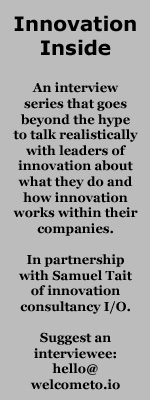Innovation advice and insights from Pizza Hut
Share
Pizza Hut has delivered an innovative product pipeline recently, through partnerships with brands including Doritos and Four’N Twenty. Fatima Syed, head of marketing and innovation at Pizza Hut’s parent company, Yum! Restaurants International, talks to Samuel Tait about how the company delivers innovation, and shares her advice on how to run a successful innovation program.
 Samuel Tait: What are some of the challenges that you have in regards to the execution of innovation?
Samuel Tait: What are some of the challenges that you have in regards to the execution of innovation?
Fatima Syed: The biggest thing is that our franchisees and their teams are trained prior to any new initiatives rolling out so that they are equipped to support the promotion.
ST: How do you evaluate innovative ideas and decide which ones take forward and progress?
 FS: Consumer testing is a critical component. We usually develop a range of concepts which can come from ideation workshops, other similar Pizza Hut markets globally, or our employees and franchisees. We then test all of the concepts with our consumers and it’s the top rated concepts in terms of purchase intent that we progress with.
FS: Consumer testing is a critical component. We usually develop a range of concepts which can come from ideation workshops, other similar Pizza Hut markets globally, or our employees and franchisees. We then test all of the concepts with our consumers and it’s the top rated concepts in terms of purchase intent that we progress with.
Once we get to the point where a product is developed that is commercially viable, we have an internal panel that’s made up of the leadership team and franchisee representatives. We take them through the products recommended to launch to ensure everyone’s on the same page and everyone’s comfortable to sign-off. Then once it is approved we’ll go into roll-out.
ST: What is the time horizon you work to for the delivery of innovation at Yum!?
FS: Anywhere from three to six months, which is actually not a long timeframe to put a new product in market. However, technology innovation takes a longer time. That can actually be quite frustrating because that’s where the world – and our consumers – are heading. But it takes a lot longer because it’s not as simple as a tangible product you put into market that people consume. With technology you have to make sure that you have tested the user experience and that it’s working the way it should. It’s definitely more expensive, and there are a lot more hurdles that you have to go through. Right now we’re working on how we make it faster to fit in with the busy lifestyles of our consumers.
ST: Innovation is inherently risky. How do you mitigate the risk that innovation brings?
FS: We have learned from past situations where we’ve had stock left over and we haven’t been able to move it. We therefore tend to look for products that are not unique to Pizza Hut. We might look for retail lines because that allows us to sell the product back into a food service brand. It actually allows you to relieve the risk pressure. The biggest learning for us was do not look for innovation or ingredients that are uniquely packaged, or uniquely developed for Pizza Hut because they may not have longevity.
I think for me the main way to mitigate risk in innovation is to ensure comprehensive testing before a product is developed. In most cases we’ll isolate the market and then we’ll test that way. Very rarely will we put a product into market that hasn’t been through consumer testing.
ST: What is the role of the consumer in supporting innovation ideas to be successful?
FS: One of the things we value is consumer feedback. With the world of social media, you get instant feedback and it is quite widespread. We’re putting a lot of emphasis on using social media as a way to garner insights from our customers on what’s working, and what’s not. You can have one-to-one conversations in real time – 10 minutes after your first ad has been on TV or 10 minutes after they’ve tried the products. It’s valuable information gathering.
The biggest challenge for us was how to distil this valuable information into something meaningful. Recently we’ve brought our community managers in-house whose job it is to not just interact with customers, but to gain key insights. I think a lot of brands use social media, but they use it purely to drive brand engagement, or to drive product news.
Not too long ago we had an issue with the Hershey’s cookie in market. The process of baking involved placing a shield on the cookie when it went through the oven otherwise it burned. We had a few customers that fed back that the cookie was amazing, but it was burnt. We knew straight away that shields weren’t being used. We could then message the customer and ascertain which local franchise we needed to speak with, reminding them the importance of using the shields with this particular product. Social media is a powerful tool for us to maintain exceptional customer service.
When you move the customer out of the process you’re in trouble. For us it’s about being customer-centric and never losing sight of the customer.
ST: What is the value of heading outside, talking with external partners, agencies and suppliers?
FS: Our agencies and suppliers are our partners, and so we rely heavily on them to understand our brand and our brand positioning, and to also challenge us and make sure that we’re staying true to the consumer insights.
We have sessions with our suppliers on the flavour trends they are seeing emerge and the role this could play with our segment. They take us through what they’re doing, the changes that are happening in their world, and the ingredients they’re looking at and they bring ingredients to life in a slightly different way. Proactive suppliers are really important for us.
Our agencies and suppliers are very comfortable to also push back and say, “No actually, you’re deviating from the consumer insight”, or “That’s not the target market”. They’re very good at keeping us on the right track because sometimes as we’re going through the stage-gate process we’re trying to adapt the product to make it work financially, but we might have moved away from the initial concept and what consumers actually rated. Our agencies will say, “That’s not what we tested”, or “That’s not what the consumers said they like”, and if we’re moving that far away, we’re better off canning it or re-testing it.
ST: What are the specific food or market trends that you are working on at the moment?
FS: Mexican and South American flavours seem to be all the rage at the moment and everyone’s doing them. You’ve got specific brands that are opening up around these cuisines. They certainly seem to be here to stay. What is really interesting is that some of the flavour trends that have been trends for years still rank highly. Flavours like Thai, Italian and Indian are still the top three, which we were really surprised about.
The new trends are really interesting but we don’t want to forget the trends and flavours that are really popular. We want to capture some of the new, evolving trends but we want to stay true to what people still know and love.
ST: How do you measure the impact and success of innovation?
FS: For me, there are three things. The first being performance versus forecast. The second, what is it actually doing in terms of sales and transactions? The third is what we call brand image trackers.
ST: What advice would you give to people to help them be successful in their innovation programs?
FS: Firstly, make sure you don’t lose sight of the customer. Keep the customer at the heart of everything that you do. If you lose sight of your customer, you’ll become irrelevant.
The second piece is to make sure that you are using innovation to build incremental sales, but without cannibalising your core. The only way you can do that is by making sure that your core business foundation is strong.
The third would be making sure that you take people on a journey. There is not one single person that can deliver innovation successfully. Take people on a journey – make them believe, and make them accountable, and that will deliver results.
In case you missed it, check out part one of this interview here.
















